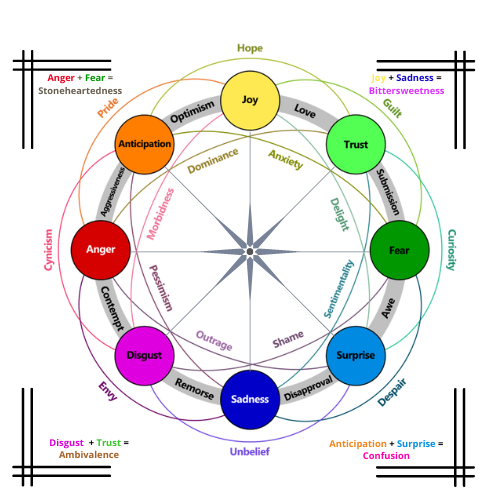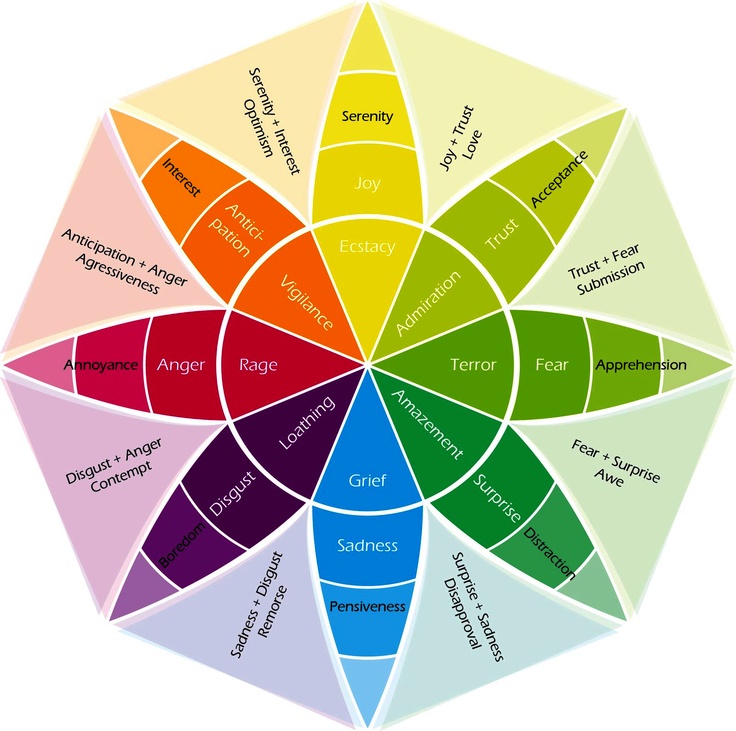Zealomancy
Zealomancy
Definition: A system of magic revolving around 8 different emotions, the intensity at which they are expressed, the effects of willpower on said emotions, and how memories can expand upon their utility. Each of the 8 emotions represents one magical element:- Joy: Holiness
- Anticipation: Electricity
- Anger: Fire
- Disgust: Air
- Sadness: Darkness
- Surprise: Earth/Rock
- Fear: Plants
- Trust: Water
Intensity
The higher the intensity of the emotion, the greater the power of the emotion and the greater toll it has on the user. Emotions generally have 4 intensities:- Miniscule intensity: No physical expression.
- Moderate Intensity: Emotion is expressed through enhanced movements and mannerisms associated with said emotion. This can lead to enhanced combat ability and has many practical uses. Little toll taken on body and or mind.
- High Intensity: Emotion is physically expressed as an element. At this point, the combat power of the Zealomancer is greatly increased. The mind and body start to deteriorate after long periods of time.
- Extreme Intensity: Emotion starts to envelop the Zealomancer. Zealomancer has an extreme tendency towards movement and mannerisms associated with said emotion and generally use them for combat. Power of element "awakens" and reaches a new form which starts to cover the Zealomancer's body. It is at this point where inexperienced Zealomancers lose themselves to the emotion, becoming a sentimental. Extreme toll on mind and body.
Illusiomancy
Defnition: An elite branch of Zealomancy which very few have ever mastered. At its core, the broad umbrella of Zealomancy is about harnessing magical power from the sentient mind to obtain a higher level of intellectual and physical power. Illusiomancy takes this aspect to the very brink. The concept behind illlusiomancy is that the sentient mind has the ability to change anything it can fathom (even natural laws). Illusiomancers use their mind to physically manifest magical power in a way they can convince their mind to manifest it, even if it isn't the natural norm. For example, the common element to be manifested from ambivalence would be ice (water + air). However, an illusiomancer could take this natural truth and defy it. Instead of ice, an illusiomancer could manifest fog, clouds, rain, snow, water vapor, and any other multitude of elemental combinations, which could all be used in quick succession. This changes the level of versatility of a given emotion from a powerful elemental weapon which is mentally draining and has little variation, to a versatile combination of elemental fusions with different uses and manifestations based on the users emotions, willpower, and knowledge. The reason Illusiomancy is only a subset of Zealomancy is due to the fact that it is generally closely aligned with the basic principles of Zealomancy. Additionally, illusiomancy heavily relies on the individual illusiomancer's mind and its quirks. Using the previous example, even if someone had not trained in Illusiomancy they could still summon fog from ambivalence if something within their mind made it naturally easier for them to manifest as an element. For example, a person who grew up in a seaside town may be more likely to manifest fog, whereas a person who grew up in a mountan village would be more likely to manifest ice. In short, the mind of an Illusiomancer is just like any other muscle in the body. It adapts to the knowledge of the user, wanting to manifest the elemental combination which makes the most sense to them. However, with enough experience and practice, an Illusiomancer can train their mind to manifest elemental combinations that may be foreign to them. This brings up the point that the compendium of emotions is a list of the most common physical manifestations among Zealomancers, not a list of the only combinations. Due to the variation of each individual's mind, there is virtually no limit to the different elemental combinations that can be manifested. In short, if you can convince your mind that it can exist, it can exist.
Type
Metaphysical, Arcane
Compendium of Emotions
Basic Emotions:- Joy: Holiness
- Anticipation: Electricity
- Anger: Fire
- Disgust: Air
- Sadness: Darkness
- Surprise: Earth/Rock
- Fear: Plants
- Trust: Water
- Joy + Anticipation = Optimism (White Lighting)
- Anticipation + Anger = Aggressiveness (Plasma)
- Anger + Disgust = Contempt (Smoke)
- Disgust + Sadness = Remorse (Poison Gas)
- Sadness + Surprise = Disapproval (Metal)
- Surprise + Fear = Awe (Nature)
- Fear + Trust = Submission (Wood)
- Trust + Joy = Love (Holy Water)
- Pride (Solar flame)
- Cynicism (Speed)
- Envy (Shadowflame)
- Disbelief (Sand)
- Despair (Poisonous Plants)
- Curiosity (Mud)
- Guilt (Nectar)
- Hope (Storm)
- Dominance (Steam)
- Morbidness (Golden Wind)
- Pessimism (Negative Charge)
- Outrage (Lava)
- Shame (Wilting Plants)
- Sentimentality (Blood)
- Delight (Crystal)
- Anxiety (Life)
- Bittersweetness (Illusion)
- Stoneheartedness (Coal)
- Confusion (Magnesis)
- Ambivalence (Ice)
- All 8 combined (Chaos)
Emotional Intensities
Anger- Annoyance
- Anger
- Rage
- Boredom
- Disgust
- Loathing
- Pensiveness
- Sadness
- Grief
- Distraction
- Surprise
- Amazement
- Apprehension
- Fear
- Terror
- Acceptance
- Trust
- Admiration
- Serenity
- Joy
- Ecstasy
- Interest
- Anticipation
- Vgigilance
Remove these ads. Join the Worldbuilders Guild











Comments